How Psoriasis Affects Women
- Overview
- Why does psoriasis affect women differently
- Psoriasis symptoms specific to women
- Physical impacts of psoriasis on women
- How psoriasis affects women’s skin health?
- How does psoriasis affect women’s overall health?
- Over-the-counter medications for psoriasis relief
- Role of online Dermatology for Consultation
- Effect of sex and gender on psoriasis management
- Treatment options for women with psoriasis
- Summary
Psoriasis: An overview
Psoriasis is a chronic autoimmune condition that affects the skin and sometimes joints. It is a non-contagious condition that is characterized by red, scaly patches on the skin that can be itchy, painful, and can affect a person’s quality of life. These patches are called plaques. They typically develop on the scalp, elbows, knees, and lower back, but can appear anywhere on the body. Psoriasis occurs when the immune system triggers the overproduction of skin cells, which accumulate on the surface and form thick, silvery scales. Psoriasis affects about 2-3% of the global population and affects both men and women at any age, but it most commonly appears between the ages of 15 and 35. However, some studies suggest that psoriasis may be slightly more common in women. The prevalence of psoriasis in women varies depending on the population and geographic location studied.
The exact cause of psoriasis is not fully understood, but it is believed to be a combination of genetic and environmental factors. Certain factors such as stress, infections, medications, and injury to the skin can also exacerbate the condition. Psoriasis is diagnosed through physical examination and skin biopsy, and treatment options include topical creams, light therapy, oral medications, and biological agents. These treatments can help manage the symptoms. While there is currently no cure for psoriasis, management of the condition can significantly improve a person’s quality of life.\\
Why does psoriasis affect women differently from men?
The underlying mechanisms of psoriasis development are complex and not fully understood. However, there are several factors that may contribute to the gender differences in psoriasis, including hormonal differences, genetic factors, and lifestyle factors.
- Hormonal differences: Hormonal changes, such as those that occur during puberty, pregnancy, and menopause, can trigger or exacerbate psoriasis. Some studies suggest that the sex hormones estrogen and progesterone may play a role in the development of psoriasis in women, as well as in the severity and course of the disease.
- Genetic factors: Psoriasis has a strong genetic component, and certain genetic variations may increase the risk of developing the disease. Women may be more likely to inherit psoriasis-related genes or have genetic differences that affect how they respond to environmental triggers.
- Lifestyle factors: Women may also be more likely to experience stress, which is a known trigger for psoriasis. In addition, women may use different skincare products or cosmetics that contain chemicals or fragrances that can irritate the skin and exacerbate psoriasis symptoms.
Psoriasis symptoms specific to women
These are some symptoms of Psoriasis based on the site of their appearance.
Genital psoriasis:
Genital psoriasis is a type of psoriasis that affects the genital area in women. Symptoms may include redness, itching, burning, and soreness in the genital area. Women with genital psoriasis may also experience pain during sexual intercourse, which can affect their sexual health and quality of life
Nail psoriasis
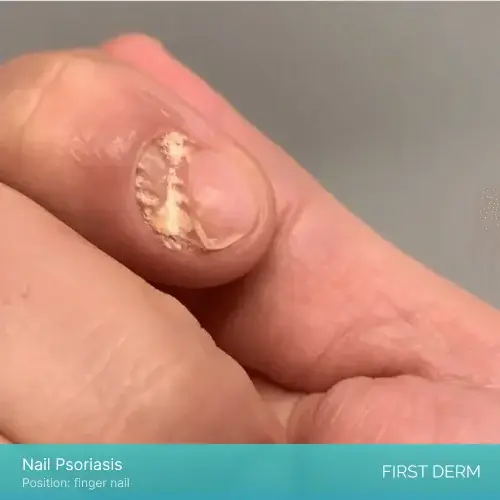
A close-up photo of a person’s hand with nail psoriasis, showing discoloration, pitting, and crumbling of the fingernails. The image illustrates the symptoms and appearance of nail psoriasis, a common condition that affects the nails of people with psoriasis
Nail psoriasis can affect the fingernails and toenails in both men and women, but it may be more common in women. Symptoms may include pitting, discoloration, thickening, and separation of the nail from the nail bed.
Scalp psoriasis
Scalp psoriasis can affect the scalp and hairline in both men and women, but it may be more common in women. Symptoms may include redness, itching, and flaking of the scalp. Women with scalp psoriasis may also experience hair loss, which can be distressing.
Physical impacts of psoriasis on women
Common types of psoriasis include plaque psoriasis, guttate psoriasis, inverse psoriasis, and pustular psoriasis. Each type of psoriasis consists of specific physical symptoms.
Plaque psoriasis
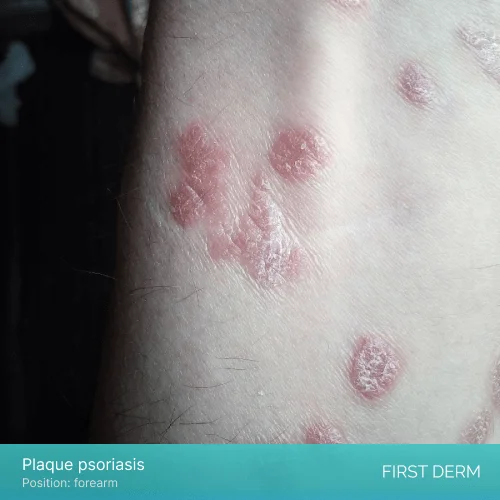
Forehand with red, scaly patches of skin that are typical of plaque psoriasis, a chronic inflammatory skin condition
The cause of plaque psoriasis is thought to be related to an overactive immune system. The symptoms may include,
- Red, raised, inflamed patches of skin
- Silvery-white scales or plaques on the affected areas
- Dry, cracked skin that may bleed
- Itching or burning sensations
Plaque psoriasis can occur on any part of the body, but it most commonly affects the scalp, elbows, knees, and lower back.
Guttate psoriasis
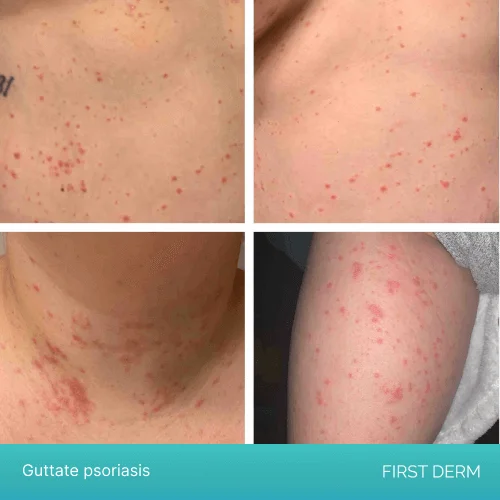
Guttate psoriasis on the neck, chest and leg of a patient
This is a less common type of psoriasis. Guttate psoriasis often appears suddenly, often in response to a bacterial infection such as strep throat. It is more common in children and young adults than in older adults. Symptoms of guttate psoriasis may include,
- Small, red, teardrop-shaped spots on the skin
- Itching or burning sensations
- Dry skin
- Scaling
Guttate psoriasis can occur on any part of the body, but it most commonly affects the trunk, arms, legs, and scalp.
Inverse psoriasis
This is also known as intertriginous psoriasis, is a type of psoriasis that affects skin folds, such as the armpits, groin, and under the breasts. It is characterized by red, smooth, and shiny patches of skin that may be painful and itchy.
Inverse psoriasis can be difficult to diagnose because it often appears in areas that are not commonly associated with psoriasis. In addition, the symptoms can be mistaken for other skin conditions such as fungal infections or contact dermatitis
Pustular psoriasis
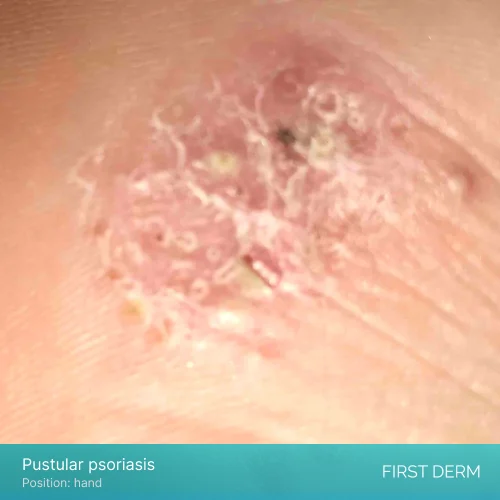
Pustular psoriasis on the hand of a patient
Pustular psoriasis is a rare form of psoriasis that causes pus-filled blisters to form on the skin. It can occur anywhere on the body but is most commonly found on the hands and feet. There are two main types of pustular psoriasis: generalized and localized.
Generalized pustular psoriasis is a rare and severe form that affects the entire body. Symptoms can include fever, chills, fatigue, and muscle weakness, in addition to the appearance of painful and itchy blisters on the skin. This type of psoriasis can be life-threatening and requires immediate medical attention.
Localized pustular psoriasis, on the other hand, affects specific areas of the body, such as the hands and feet, and is typically less severe than the generalized form. The blisters can be painful and may cause the affected areas to become red and swollen.
How psoriasis affects women’s skin health?
The impact of Psoriasis on skin health can be significant. It includes potential complications such as infections, scarring, and hyperpigmentation.
Infections
People with psoriasis are more prone to skin infections due to the skin barrier being compromised in areas affected by psoriasis. The thickened, scaly patches of psoriasis can create a moist environment that is favorable for the growth of bacteria and fungi, leading to infection. Scratching or picking at psoriasis lesions can also break the skin and increase the risk of infection.
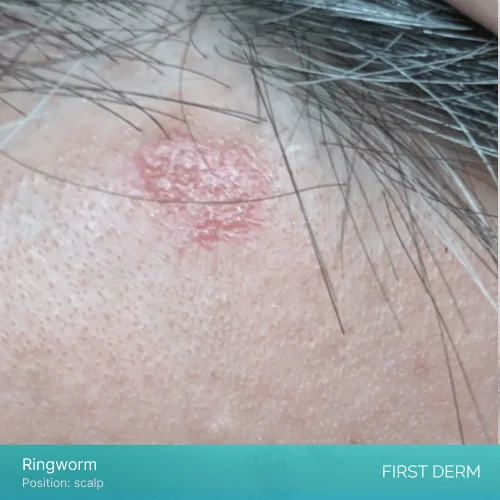
Ringworm of the scalp (tinea capitis) in a patient
Common skin infections that can occur in people with psoriasis include; Bacterial infections, such as cellulitis, which can cause redness, swelling, and warmth in the affected area. Fungal infections, such as ringworm or jock itch, can cause itching, redness, and scaling. Viral infections, such as herpes simplex or shingles, can cause painful blisters and lesions.
Scarring
Psoriasis can cause scarring of the skin in some cases, particularly if it is left untreated or if a person scratches or picks at the affected areas. When psoriasis patches become thick and scaly, they can develop cracks or fissures, which can become deep and lead to scarring.
Scarring from psoriasis is more common in areas of the skin that are frequently exposed to trauma or friction, such as the knees, elbows, and scalp. The scarring can be unsightly and may affect a person’s self-esteem.
Hyperpigmentation
Hyperpigmentation, or the darkening of the skin, can occur in areas affected by psoriasis. This is due to inflammation and the accumulation of melanin in the skin, which can happen as a result of prolonged exposure to ultraviolet (UV) radiation or trauma to the skin.
Hyperpigmentation in psoriasis can be temporary or permanent, depending on the severity and duration of the condition. In some cases, hyperpigmentation may resolve on its own as psoriasis symptoms improve or with the use of topical or systemic treatments. In other cases, hyperpigmentation may persist even after psoriasis is well-controlled.
How does psoriasis affect women’s overall health?
Psoriasis can affect a person’s overall health in several ways. People with psoriasis have a higher risk of developing other health conditions such as psoriatic arthritis, cardiovascular disease, and metabolic syndromes.
Psoriatic arthritis
This is a type of arthritis that can occur in people who have psoriasis. Psoriatic arthritis can cause pain, swelling, and stiffness in the joints, and in some cases, can cause damage to the joints and surrounding tissues. The symptoms of psoriatic arthritis can vary but often include joint pain, stiffness, and swelling, especially in the fingers and toes. Other symptoms may include fatigue, nail changes, and eye inflammation.
Cardiovascular diseases
Psoriasis has been associated with an increased risk of cardiovascular disease. Cardiovascular disease includes conditions that affect the heart and blood vessels, such as coronary artery disease, heart failure, and stroke. Here are some ways that psoriasis may contribute to the development of cardiovascular disease:
- Inflammation: Psoriasis is associated with chronic inflammation, which can contribute to the development of atherosclerosis, a condition in which plaque builds up in the arteries, leading to reduced blood flow to the heart and other organs.
- Risk factors: People with psoriasis are more likely to have risk factors for cardiovascular diseases, such as obesity, high blood pressure, high cholesterol, and diabetes.
- Medications: Some medications used to treat psoriasis, such as systemic corticosteroids, can increase the risk of cardiovascular disease.
- Genetic factors: Psoriasis and cardiovascular disease share some genetic factors, which may contribute to their co-occurrence.
Metabolic syndromes
Psoriasis can increase the risk of developing metabolic syndromes. Metabolic syndrome is a cluster of conditions that occur together, including diabetes, obesity, high blood pressure, high blood sugar levels, and abnormal cholesterol levels. Some factors contribute to metabolic syndromes during psoriasis are,
- Chronic inflammation: Psoriasis is associated with chronic inflammation, which can lead to insulin resistance and impaired glucose metabolism. This can contribute to the development of type 2 diabetes.
- Adipokines: Adipokines are hormones produced by fat cells that regulate metabolism. People with psoriasis have been found to have altered levels of adipokines, which can contribute to metabolic syndrome.
- Medications: Some medications used to treat psoriasis, such as corticosteroids, can contribute to metabolic syndrome by causing weight gain and increasing blood sugar levels.
- Lifestyle factors: People with psoriasis may be more likely to have unhealthy lifestyle factors such as a sedentary lifestyle and a diet high in processed foods, which can contribute to metabolic syndrome.
- Shared genetic factors: Psoriasis and metabolic syndrome share some genetic factors, which may contribute to their co-occurrence.
Over-the-counter medications for psoriasis relief
There is no cure for psoriasis, but there are many over-the-counter (OTC) medications that can help relieve its symptoms. Some OTC medications that may be helpful for psoriasis relief are,
There is no cure for psoriasis, but there are many over-the-counter (OTC) medications that can help relieve its symptoms. Some OTC medications that may be helpful for psoriasis relief are,
Topical corticosteroids
These are anti-inflammatory creams and ointments that can help reduce redness and itching. They are available in different strengths, so it is important to choose the right one according to the need.
Salicylic acid
This is a medication that helps remove scales and dead skin cells, which can be particularly helpful for people with psoriasis on their scalp.
Coal tar
This is a topical medication that can help reduce inflammation and scaling. It is available in shampoos, creams, and ointments.
Moisturizers
Keeping the skin well-moisturized can help reduce the itching and dryness associated with psoriasis. Moisturizers that are fragrance-free and designed for sensitive skin are recommended.
Vitamin D analogues
These are medications that mimic the effects of vitamin D on the skin, which can help reduce inflammation and scaling.
Aloe vera
Aloe vera is a natural moisturizer that can help soothe the skin and reduce inflammation.
It is important to note that while these medications may be helpful for psoriasis relief, they may not work for everyone. It is always a good idea to talk to a dermatologist before trying any new medications or treatments for psoriasis.
Role of online Dermatology for Consultation on psoriasis
Online dermatology consultation would be a better approach for getting a professional opinion about your skin condition. Some potential benefits and limitations of online dermatology consultation for psoriasis are:
Benefits
- Accessibility: Online dermatology consultation can be accessed from anywhere, making it easier for individuals who live in remote areas or have limited mobility to access dermatological care.
- Privacy: Some individuals may feel embarrassed or stigmatized by their psoriasis, and online consultation can provide them with a more private and confidential way to seek treatment.
- Convenience: Online consultation allows patients to schedule appointments at times that are more convenient for them, without the need to take time off work or travel to a clinic.
- Cost-effective: Online consultation can be more cost-effective than in-person visits, especially for individuals who have to travel long distances to see a dermatologist.
Limitations
- Lack of personal touch: Online consultation may lack the personal touch and human connection that can be provided by in-person visits, which may affect the patient’s overall experience and satisfaction with the care provided.
- Technological barriers: Some individuals may not have access to the technology required for online consultation, such as a reliable internet connection or a webcam-enabled device.
- Prescription limitations: In some cases, dermatologists may not be able to prescribe medications or treatments through online consultation, which may require an in-person visit.
Online dermatology consultation can be a useful tool for individuals with psoriasis, especially for those facing social barriers to in-person care. However, it is important to consider the potential limitations and ensure that online consultation is used appropriately and in conjunction with in-person visits when necessary.
More than 70% of our users get better with Over-the-Counter Medication
Avoid an unnecessary visit to a doctor! Receive expert dermatological advice from the comfort of your own home.
Effect of sex and gender on psoriasis management
Sex and gender can play an important role in psoriasis management such as differences in disease presentation, treatment response, and comorbidity risks.
Disease Presentation
Psoriasis tends to have different presentation patterns in males and females. In general, males are more likely to have severe psoriasis, with lesions that are thicker and cover more of the body. Females, on the other hand, are more likely to have psoriasis in areas that are harder to treat, such as the face, genitals, and breasts.
Treatment Response
Studies have shown that females tend to respond better to certain treatments, such as phototherapy and biologics, than males. This may be due to differences in body composition and hormone levels between the sexes. Additionally, some medications, such as methotrexate, may have different side effects in males and females.
Comorbidity Risks
Psoriasis is associated with an increased risk of several comorbidities, including cardiovascular disease, metabolic syndrome, and depression. These risks may be different between males and females. For example, males with psoriasis are more likely to have metabolic syndrome and cardiovascular disease, while females with psoriasis are more likely to have depression and anxiety.
Treatment options for women with psoriasis
While there is currently no cure for psoriasis, there are a variety of treatment options available to manage symptoms and improve overall well-being. Some treatment options for women with psoriasis are:
Systemic medications
In addition to biological therapies, there are other systemic medications that can be used to treat psoriasis. These medications include oral retinoids, cyclosporine, and methotrexate. However, these medications may have side effects and should only be used under the guidance of a healthcare provider.
Topical medications
Topical medications are applied directly to the skin and can be used to manage mild to moderate psoriasis. These medications include corticosteroids, vitamin D analogues, and retinoids.
Lifestyle modifications
Certain lifestyle modifications can help manage symptoms of psoriasis. These include:
- Stress management: Stress can trigger psoriasis flares, so finding ways to manage stress, such as through mindfulness practices or exercise, can be beneficial.
- Diet: There is some evidence that a healthy diet rich in fruits, vegetables, and omega-3 fatty acids may help manage psoriasis symptoms.
- Exercise: Exercise can help reduce stress and inflammation, which may help manage psoriasis symptoms.
- Sun exposure: Moderate sun exposure can help improve psoriasis symptoms, but it’s important to protect the skin from sun damage.
- Quitting smoking: Smoking can worsen psoriasis symptoms, so quitting smoking can be beneficial.
Summary
In view of all the facts on how psoriasis affects, women, there are physical, emotional, and social impacts on women. By understanding the physical, emotional, and social impacts of psoriasis, women can take steps to manage their condition and improve their overall well-being.
This may involve seeking medical treatment, practicing self-care, seeking support from family and friends, and advocating for themselves. in social and professional situations. It is also important for women with psoriasis to educate others about the condition, to reduce stigma and increase understanding.
Disclaimer
The information provided in this content is for educational and informational purposes only and is not intended as a substitute for professional medical advice, diagnosis, or treatment. Always seek the advice of your physician or other qualified health providers with any questions you may have regarding a medical condition.
References:
- Guillet, Carole MDa,b; Seeli, Corsin MMedc; Nina, Meienberger MMeda,b; Maul, Lara Valeska MDd; Maul, Julia-Tatjana MDa,b,* , International Journal of Women’s Dermatology, The impact of gender and sex in psoriasis: What to be aware of when treating women with psoriasis, DOI: 10.1097/JW9.0000000000000010
- L S Winterfield, A Menter, K Gordon, A Gottlieb, Psoriatic arthritis and psoriasis: treatment, http://dx.doi.org/10.1136/ard.2004.032276
- Alexander Egeberg, MD, Ph.D., Espen Jimenez-Solem, MD, Ph.D., Lone Skov, MD, Ph.D., Simon Francis Thomsen, MD, Ph.D., Psoriasis and adverse pregnancy outcomes, https://doi.org/10.1016/j.jdin.2022.03.009
Ask a Dermatologist Now
Anonymous, fast and secure!

The Specialist doctor from the University Hospital in Gothenburg, alumnus UC Berkeley. My doctoral dissertation is about Digital Health and I have published 5 scientific articles in teledermatology and artificial intelligence and others.




